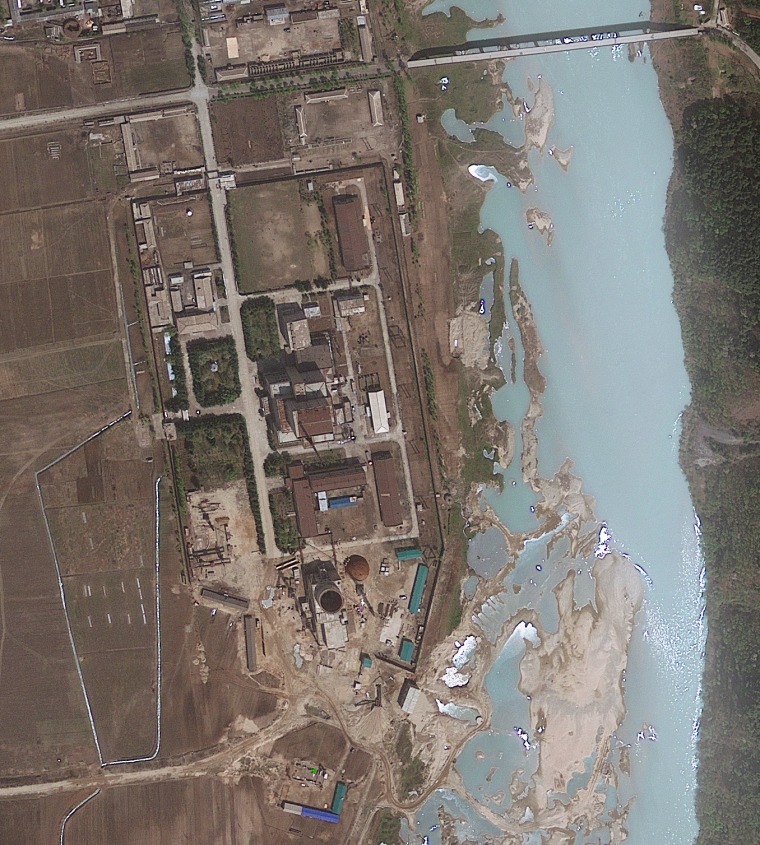WASHINGTON — A recent satellite image appears to show North Korea is restarting a plutonium reactor, in a move that could raise renewed international alarm over its nuclear weapons program, a U.S. research institute said Wednesday.
The 5 megawatt reactor at the Nyongbyon nuclear facility was shuttered in 2007 under the terms of a disarmament agreement. Pyongyang announced plans in April to restart it amid a litany of threats toward the U.S. and South Korea after it faced tougher international censure over its latest nuclear and rocket tests.
North Korea has since toned down its rhetoric and stepped up diplomacy with rival South Korea, but Wednesday's finding by the U.S.-Korea Institute at Johns Hopkins School of Advanced International Studies is a sign that the regime of Kim Jong Un is pressing ahead with its nuclear program.
Without access to the secretive facility, it is difficult to say with certainty that the reactor has restarted, but the institute says an Aug. 31 commercial satellite image shows white steam rising from a building next to the reactor. The building houses steam turbines and electric generators that are driven by heat generated by the reactor. The color and volume of the steam is consistent with the electrical generating system being readied to come online, indicating that the reactor is in or nearing operation, the institute says.
The analysis was written by Jeffrey Lewis and Nick Hansen and provided to The Associated Press ahead of publication on the institute's website, 38 North.
When North Korea announced its plans in April, State Department spokeswoman Victoria Nuland told reporters that restarting the plutonium reactor would be "extremely alarming" but added: "There's a long way to go between a stated intention and actually being able to pull it off."
Department spokesman for East Asian and Pacific affairs, Jason Rebholz, said Wednesday that North Korea's nuclear program remains a matter of "serious concern." Rebholz reiterated the call for Pyongyang to comply with its previous commitments and abandon all nuclear weapons and nuclear programs. He did not directly address the reactor report, saying the department does not comment on intelligence matters.
South Korea's National Intelligence Service also said it could not confirm the reactor report because it involves confidential intelligence.
Commercial satellite images taken in recent months had indicated preparations for restarting the reactor were progressing rapidly. In June, the institute predicted the reactor could be up and running by the end of August, depending on the availability of fresh fuel rods to power it.
The reactor can be used both to generate electricity and produce fissile material for nuclear weapons, and once it is operating, can produce about 6 kilograms of plutonium a year — enough for one or two bombs. Experts estimate North Korea already has enough plutonium for between four to eight crude weapons.
"The reactor restart fits a pattern of continued expansion of North Korea's WMD programs short of conducting outright nuclear and missile tests," said Joel Wit, a former State Department official and editor of 38 North. WMD stands for weapons of mass destruction.
"An operating reactor will enable Pyongyang to renew the production of plutonium, albeit on a small scale, that will enable it to slowly expand its stockpile of nuclear bombs," he said.
The development could intensify pressure on Washington to restart international aid-for-disarmament negotiations with Pyongyang, stalled since 2009, although the differences between them are stark.
The U.S. is demanding North Korea first recommit to past agreements on denuclearization, while Pyongyang insists that it be recognized in disarmament negotiations as a nuclear power, which the U.S. refuses to do.
North Korea has dialed down its bellicose rhetoric in recent months and on Wednesday agreed with South Korea to restart operations at a jointly run factory park that Pyongyang shut down in April.
But despite the easing tensions, analysis of recent commercial satellite photos also shows Pyongyang may also be doubling the size of its uranium enrichment plant — a potential, second source of fissile material for nuclear weapons — and expanding its main rocket launch site, located on its west coast near China.
North Korea has conducted three underground, nuclear test explosions since 2006. The latest, in February 2013, prompted international condemnation and a tightening of sanctions by the U.N. Security Council. The sanctions are intended to hinder the North's development of nuclear weapons and ballistic missiles.
The North's weapons capabilities are a subject of conjecture, but experts doubt it has yet mastered how to miniaturize a nuclear device that fit on a long-range missile capable of hitting the United States, although it is possible it may have for shorter-range missiles
